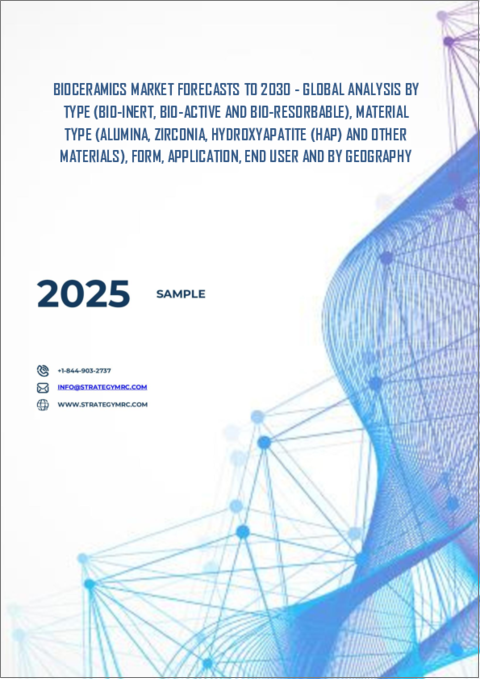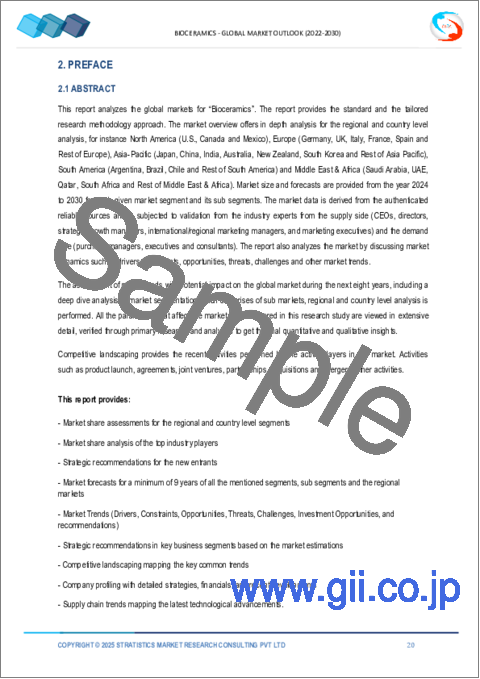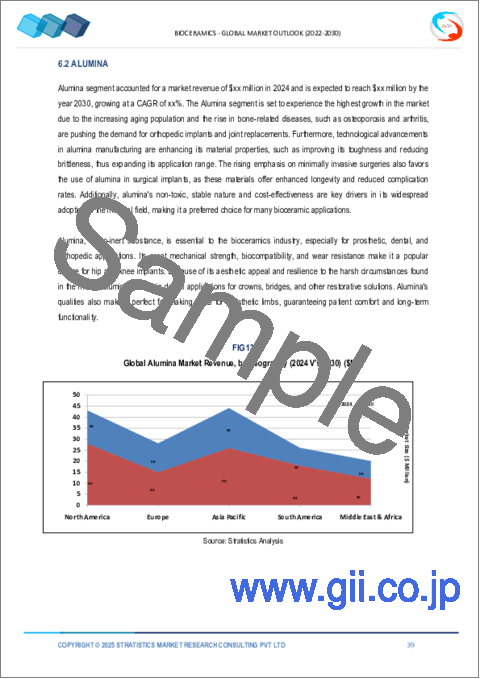|
|
市場調査レポート
商品コード
1603804
バイオセラミックス市場の2030年までの予測: タイプ別、材料タイプ別、形態別、用途別、エンドユーザー別、地域別の世界分析Bioceramics Market Forecasts to 2030 - Global Analysis By Type (Bio-inert, Bio-active and Bio-resorbable), Material Type (Alumina, Zirconia, Hydroxyapatite (HAp) and Other Materials), Form, Application, End User and By Geography |
||||||
カスタマイズ可能
|
|||||||
| バイオセラミックス市場の2030年までの予測: タイプ別、材料タイプ別、形態別、用途別、エンドユーザー別、地域別の世界分析 |
|
出版日: 2024年11月11日
発行: Stratistics Market Research Consulting
ページ情報: 英文 200+ Pages
納期: 2~3営業日
|
全表示
- 概要
- 図表
- 目次
Stratistics MRCによると、バイオセラミックスの世界市場は2024年に82億米ドルを占め、予測期間中のCAGRは8.3%で成長し、2030年には133億米ドルに達する見込みです。
バイオセラミックスは、特に歯科および医療用途のために作られたセラミック材料です。生体適合性が高いため、人体内で使用しても安全です。生体組織と良好に相互作用する能力により、組織工学、歯科修復、整形外科インプラントで人気があります。生体不活性、生体活性、生体吸収性という3つのカテゴリーに分類されるバイオセラミックスに使用される材料には、通常、ハイドロキシアパタイト、ジルコニア、アルミナ、リン酸カルシウムセラミックなどがあります。
米国整形外科学会(AAOS)によると、2019年には、股関節と膝関節を含む約125万件のTJA手術が行われました。
筋骨格系疾患の増加
変形性関節症、骨粗鬆症、歯の問題のような筋骨格系疾患の有病率の増加は、バイオセラミックスの需要を促進しています。世界人口の高齢化に伴い、整形外科用インプラント、歯科補綴物、骨移植の必要性が高まっています。バイオセラミックスは生体適合性に優れ、天然の骨組織と一体化するため、このような用途に最適です。そのため、変性関節疾患や歯科疾患の負担が増加しており、市場の成長を後押ししています。
耐久性への懸念
バイオセラミックスには多くの利点がある一方で、従来の金属インプラントと比較すると、長期的な耐久性や機械的強度に懸念が残る。セラミック材料は脆く、高応力下で破壊されやすいです。このため、特定の荷重を受ける用途での使用は制限されます。長期間にわたるインプラントの故障や破損の可能性から、バイオセラミックスを広範囲に使用することをためらう外科医もいます。
医療技術の進歩
3Dプリンティング、ナノテクノロジー、組織工学などの医療技術の急速な進歩は、バイオセラミックスに新たな機会をもたらしています。3Dプリンティングは、複雑な多孔質構造を持つカスタム形状のインプラントの作製を可能にします。ナノ構造のバイオセラミックスは、強化された生物学的および機械的特性を示します。バイオセラミックスの足場を用いた組織工学的アプローチは、骨や軟骨の再生に有望です。これらの技術的進歩により、医療機器におけるバイオセラミックス材料の潜在的用途が拡大し、性能が向上しています。
厳しい規制要件
医療機器業界は、特にバイオセラミックスのような移植可能な材料について、厳しい規制監督に直面しています。新しいバイオセラミックス製品の規制承認を得るには、広範な試験と臨床試験が必要であり、時間と費用がかかります。異なる地域で規制や基準が変わることは、複雑さを増します。厳しい品質管理と文書化要件は、製造コストを増加させる。長い承認プロセスと高い規制障壁は、バイオセラミックス分野の市場成長と技術革新を脅かします。
COVID-19の影響:
COVID-19の大流行は2020年のバイオセラミックス市場を大きく混乱させました。選択手術や歯科治療が延期され、整形外科用および歯科用インプラントの需要が減少しました。サプライチェーンの混乱は原材料の入手と生産に影響を与えました。しかし、市場は回復力を示し、ヘルスケア活動の正常化とともに回復しつつあります。パンデミックは感染管理の重要性を浮き彫りにし、抗菌性バイオセラミックスへの関心を高める可能性があります。全体として、COVID-19は短期的な後退を引き起こしたもの、バイオセラミックス市場の長期的な成長軌道に永続的な悪影響を及ぼすことはないと予想されます。
予測期間中、バイオ不活性セグメントが最大になる見込み
バイオ不活性セグメントは、その優れた機械的特性と化学的安定性により、予測期間中最大の市場シェアを占めると予測されます。これらの材料は、人工股関節や人工膝関節のような荷重を支える整形外科用インプラントに広く使用されています。体組織との反応性が低いため、長期間の移植に適しています。変形性関節症の有病率の増加と人工関節置換術の件数の増加が、生体不活性バイオセラミックスの需要を牽引しています。その臨床実績と確立された製造工程が、市場の優位性に寄与しています。
予測期間中、リン酸カルシウムセラミックス分野のCAGRが最も高くなると予想されます。
予測期間中、リン酸カルシウムセラミックス分野が最も高いCAGRで成長すると予想されます。これらの材料は天然骨のミネラル成分に酷似しており、優れた生物活性とオッセオインテグレーションを提供します。歯科インプラント、骨移植、金属インプラントのコーティングなどに使用されることが多くなっています。再生医療と組織工学への注目の高まりが、リン酸カルシウム足場の研究を後押ししています。骨の成長とリモデリングを促進するリン酸カルシウム足場は、整形外科や歯科の様々な用途に魅力的であり、市場の急速な拡大を牽引しています。
最大のシェアを占める地域
予測期間中、欧州がバイオセラミックス市場シェアを独占すると予想されます。この地域は人口が多く高齢化が進んでおり、ヘルスケア支出も多いことから、整形外科用および歯科用インプラントの需要が高まっています。欧州には、バイオセラミックスの技術革新に注力する大手医療機器メーカーや研究機関が強い存在感を示しています。ドイツやフランスなどの国々では、インプラント治療に対する好意的な償還政策が市場の成長を支えています。この地域の高度なヘルスケアインフラと新しい医療技術の早期導入が、バイオセラミックス市場におけるリーダーシップに寄与しています。
CAGRが最も高い地域:
北米がバイオセラミックス市場で最も高い成長率を示すと予測されます。同地域の生体材料と再生医療における活発な研究開発活動が、バイオセラミックス技術の革新を促進しています。歯科および整形外科疾患の有病率の増加とヘルスケア意識の高まりが需要を押し上げています。主要な市場企業の存在と、新規バイオセラミックス製品の臨床試験の進行が、市場の急速な拡大に寄与しています。先端医療用インプラントへの投資拡大と低侵襲手術へのシフトが北米市場の成長をさらに加速させています。
無料のカスタマイズサービス
本レポートをご購読のお客様には、以下の無料カスタマイズオプションのいずれかをご利用いただけます:
- 企業プロファイル
- 追加市場企業の包括的プロファイリング(3社まで)
- 主要企業のSWOT分析(3社まで)
- 地域セグメンテーション
- 顧客の関心に応じた主要国の市場推計・予測・CAGR(注:フィージビリティチェックによる)
- 競合ベンチマーキング
- 製品ポートフォリオ、地理的プレゼンス、戦略的提携に基づく主要企業のベンチマーキング
目次
第1章 エグゼクティブサマリー
第2章 序文
- 概要
- ステークホルダー
- 調査範囲
- 調査手法
- データマイニング
- データ分析
- データ検証
- 調査アプローチ
- 調査情報源
- 1次調査情報源
- 2次調査情報源
- 前提条件
第3章 市場動向分析
- 促進要因
- 抑制要因
- 機会
- 脅威
- 用途分析
- エンドユーザー分析
- 新興市場
- COVID-19の影響
第4章 ポーターのファイブフォース分析
- 供給企業の交渉力
- 買い手の交渉力
- 代替品の脅威
- 新規参入業者の脅威
- 競争企業間の敵対関係
第5章 世界のバイオセラミックス市場:タイプ別
- 生体不活性
- 生体活性
- 生体吸収性
第6章 世界のバイオセラミックス市場:材料タイプ別
- アルミナ
- ジルコニア
- ハイドロキシアパタイト(HAp)
- ガラスセラミックス
- バイオアクティブガラス
- ガラス強化セラミックス
- リン酸カルシウムセラミック
- リン酸三カルシウム(TCP)
- 二相性リン酸カルシウム(BCP)
- その他の材料タイプ
第7章 世界のバイオセラミックス市場:形態別
- 粉末
- 液体
第8章 世界のバイオセラミックス市場:用途別
- 整形外科
- 歯科
- 組織工学
- ドラッグデリバリー
- その他の用途
第9章 世界のバイオセラミックス市場:エンドユーザー別
- 病院
- クリニック
- 調査機関
- その他のエンドユーザー
第10章 世界のバイオセラミックス市場:地域別
- 北米
- 米国
- カナダ
- メキシコ
- 欧州
- ドイツ
- 英国
- イタリア
- フランス
- スペイン
- その他欧州
- アジア太平洋
- 日本
- 中国
- インド
- オーストラリア
- ニュージーランド
- 韓国
- その他アジア太平洋地域
- 南米
- アルゼンチン
- ブラジル
- チリ
- その他南米
- 中東・アフリカ
- サウジアラビア
- アラブ首長国連邦
- カタール
- 南アフリカ
- その他中東とアフリカ
第11章 主な発展
- 契約、パートナーシップ、コラボレーション、合弁事業
- 買収と合併
- 新製品発売
- 事業拡大
- その他の主要戦略
第12章 企業プロファイリング
- CoorsTek, Inc.
- Kyocera Corporation
- Morgan Advanced Materials Plc
- CeramTec GmbH
- Tosoh Ceramics Co., Ltd.
- Institut Straumann AG
- Berkeley Advanced Biomaterials
- DSM
- Stryker Corporation
- Dentsply Sirona
- Zimmer-Biomet Holdings
- 3M Company
- BONESUPPORT
- DePuy Synthes
- Amedica Corporation
- Nobel Biocare Services AG
- CAM Bioceramics
- Collagen Matrix Inc.
List of Tables
- Table 1 Global Bioceramics Market Outlook, By Region (2022-2030) ($MN)
- Table 2 Global Bioceramics Market Outlook, By Type (2022-2030) ($MN)
- Table 3 Global Bioceramics Market Outlook, By Bio-inert (2022-2030) ($MN)
- Table 4 Global Bioceramics Market Outlook, By Bio-active (2022-2030) ($MN)
- Table 5 Global Bioceramics Market Outlook, By Bio-resorbable (2022-2030) ($MN)
- Table 6 Global Bioceramics Market Outlook, By Material Type (2022-2030) ($MN)
- Table 7 Global Bioceramics Market Outlook, By Alumina (2022-2030) ($MN)
- Table 8 Global Bioceramics Market Outlook, By Zirconia (2022-2030) ($MN)
- Table 9 Global Bioceramics Market Outlook, By Hydroxyapatite (HAp) (2022-2030) ($MN)
- Table 10 Global Bioceramics Market Outlook, By Glass Ceramics (2022-2030) ($MN)
- Table 11 Global Bioceramics Market Outlook, By Bioactive Glass (2022-2030) ($MN)
- Table 12 Global Bioceramics Market Outlook, By Glass-Reinforced Ceramics (2022-2030) ($MN)
- Table 13 Global Bioceramics Market Outlook, By Calcium Phosphate Ceramics (2022-2030) ($MN)
- Table 14 Global Bioceramics Market Outlook, By Tricalcium Phosphate (TCP) (2022-2030) ($MN)
- Table 15 Global Bioceramics Market Outlook, By Biphasic Calcium Phosphate (BCP) (2022-2030) ($MN)
- Table 16 Global Bioceramics Market Outlook, By Other Material Types (2022-2030) ($MN)
- Table 17 Global Bioceramics Market Outlook, By Form (2022-2030) ($MN)
- Table 18 Global Bioceramics Market Outlook, By Powder (2022-2030) ($MN)
- Table 19 Global Bioceramics Market Outlook, By Liquid (2022-2030) ($MN)
- Table 20 Global Bioceramics Market Outlook, By Application (2022-2030) ($MN)
- Table 21 Global Bioceramics Market Outlook, By Orthopedics (2022-2030) ($MN)
- Table 22 Global Bioceramics Market Outlook, By Dentistry (2022-2030) ($MN)
- Table 23 Global Bioceramics Market Outlook, By Tissue Engineering (2022-2030) ($MN)
- Table 24 Global Bioceramics Market Outlook, By Drug Delivery (2022-2030) ($MN)
- Table 25 Global Bioceramics Market Outlook, By Other Applications (2022-2030) ($MN)
- Table 26 Global Bioceramics Market Outlook, By End User (2022-2030) ($MN)
- Table 27 Global Bioceramics Market Outlook, By Hospitals (2022-2030) ($MN)
- Table 28 Global Bioceramics Market Outlook, By Clinics (2022-2030) ($MN)
- Table 29 Global Bioceramics Market Outlook, By Research Institutes (2022-2030) ($MN)
- Table 30 Global Bioceramics Market Outlook, By Other End Users (2022-2030) ($MN)
Note: Tables for North America, Europe, APAC, South America, and Middle East & Africa Regions are also represented in the same manner as above.
According to Stratistics MRC, the Global Bioceramics Market is accounted for $8.2 billion in 2024 and is expected to reach $13.3 billion by 2030, growing at a CAGR of 8.3% during the forecast period. Bioceramics are ceramic materials created especially for dental and medical applications. They are safe to use inside the human body because of their biocompatibility. Their ability to interact well with biological tissues makes them popular in tissue engineering, dental restorations, and orthopedic implants. The materials used to make bioceramics, which fall into three categories-bioinert, bioactive, and bioresorbable-usually include hydroxyapatite, zirconia, alumina, and calcium phosphate ceramics.
According to the American Academy of Orthopaedic Surgeons (AAOS) in 2019, approximately 1.25 million TJA procedures, including hip and knee arthroplasties, were performed.
Market Dynamics:
Driver:
Rising incidence of musculoskeletal conditions
The increasing prevalence of musculoskeletal disorders like osteoarthritis, osteoporosis, and dental issues is driving demand for bioceramics. As the global population ages, there is growing need for orthopedic implants, dental prosthetics, and bone grafts. Bioceramics offer excellent biocompatibility and integration with natural bone tissue, making them ideal for such applications. The rising burden of degenerative joint diseases and dental problems is thus propelling market growth.
Restraint:
Durability concerns
While bioceramics offer many advantages, there are still some concerns about their long-term durability and mechanical strength compared to traditional metallic implants. Ceramic materials can be brittle and prone to fracture under high stress. This limits their use in certain load-bearing applications. The potential for implant failure or breakage over time makes some surgeons hesitant to use bioceramics extensively.
Opportunity:
Advancements in medical technology
Rapid progress in medical technologies like 3D printing, nanotechnology, and tissue engineering is creating new opportunities for bioceramics. 3D printing allows for the fabrication of custom-shaped implants with intricate porous structures. Nanostructured bioceramics exhibit enhanced biological and mechanical properties. Tissue engineering approaches using bioceramic scaffolds show promise for regenerating bone and cartilage. These technological advancements are expanding the potential applications and improving the performance of bioceramic materials in medical devices.
Threat:
Stringent regulatory requirements
The medical device industry faces rigorous regulatory oversight, particularly for implantable materials like bioceramics. Obtaining regulatory approvals for new bioceramic products involves extensive testing and clinical trials, which can be time-consuming and expensive. Changing regulations and standards across different regions add complexity. Stringent quality control and documentation requirements increase manufacturing costs. The lengthy approval process and high regulatory barriers pose a threat to market growth and innovation in the bioceramics sector.
Covid-19 Impact:
The COVID-19 pandemic significantly disrupted the bioceramics market in 2020. Elective surgeries and dental procedures were postponed, reducing demand for orthopedic and dental implants. Supply chain disruptions affected raw material availability and production. However, the market showed resilience and is recovering as healthcare activities normalize. The pandemic highlighted the importance of infection control, potentially boosting interest in antimicrobial bioceramics. Overall, while causing short-term setbacks, COVID-19 is not expected to have lasting negative impacts on the long-term growth trajectory of the bioceramics market.
The bio-inert segment is expected to be the largest during the forecast period
The bio-inert segment is projected to hold the largest market share over the forecasted timeframe due to their excellent mechanical properties and chemical stability. These materials are widely used in load-bearing orthopedic implants like hip and knee replacements. Their low reactivity with body tissues makes them suitable for long-term implantation. The growing prevalence of osteoarthritis and rising number of joint replacement surgeries are driving demand for bio-inert bioceramics. Their proven clinical track record and established manufacturing processes contribute to their market dominance.
The calcium phosphate ceramics segment is expected to have the highest CAGR during the forecast period
During the projection period, the calcium phosphate ceramics segment is expected to grow at the highest CAGR. These materials closely resemble the mineral component of natural bone, offering superior bioactivity and osseointegration. They are increasingly used in dental implants, bone grafts, and coatings for metallic implants. The rising focus on regenerative medicine and tissue engineering is boosting research into calcium phosphate scaffolds. Their ability to promote bone growth and remodeling makes them attractive for various orthopedic and dental applications, driving rapid market expansion.
Region with largest share:
Europe is expected to dominate the bioceramics market share during the forecast period. The region's large and aging population, coupled with high healthcare expenditure, drives demand for orthopedic and dental implants. Europe has a strong presence of leading medical device manufacturers and research institutions focusing on bioceramic innovations. Favorable reimbursement policies for implant procedures in countries like Germany and France support market growth. The region's advanced healthcare infrastructure and early adoption of new medical technologies contribute to its market leadership in bioceramics.
Region with highest CAGR:
North America is projected to exhibit the highest growth rate in the bioceramics market. The region's robust research and development activities in biomaterials and regenerative medicine are driving innovation in bioceramic technologies. The increasing prevalence of dental and orthopedic disorders, coupled with rising healthcare awareness, is boosting demand. The presence of key market players and ongoing clinical trials for novel bioceramic products contribute to rapid market expansion. Growing investments in advanced medical implants and the shift towards minimally invasive surgeries are further accelerating market growth in North America..
Key players in the market
Some of the key players in Bioceramics Market include CoorsTek, Inc., Kyocera Corporation, Morgan Advanced Materials Plc, CeramTec GmbH, Tosoh Ceramics Co., Ltd., Institut Straumann AG, Berkeley Advanced Biomaterials, DSM, Stryker Corporation, Dentsply Sirona, Zimmer-Biomet Holdings, 3M Company, BONESUPPORT, DePuy Synthes, Amedica Corporation, Nobel Biocare Services AG, CAM Bioceramics, and Collagen Matrix Inc.
Key Developments:
In October 2024, Straumann Group has increased its stake in Createch Medical and acquired shares in botiss biomaterials. These acquisitions enhance Straumann's capabilities in CAD/CAM prosthetic solutions and regenerative biomaterials for dental implantology.
In August 2024, Kyoto Sangyo University, Kyocera, and Photocross Collaborate on World-First Ground-Based Telescope Innovations. To realize a reflecting telescope equipped with a large, lightweight fine cordierite mirror, a world's first achievement, and to develop ceramic reflective optical systems for infrared astronomical observation instruments, Kyoto Sangyo University, Kyocera Corporation (hereafter "Kyocera"), and Photocross, Co., Ltd. (hereafter "Photocross") have reached a comprehensive and detailed agreement. This agreement outlines each party's roles and responsibilities, the project timeline, and the expected outcomes, ensuring a coordinated and effective collaboration.
In June 2024, CeramTec introduced Sinalit, a silicon nitride-based substrate at the PCIM Europe trade fair. This product expands their portfolio of high-performance ceramics for medical technology.
Types Covered:
- Bio-inert
- Bio-active
- Bio-resorbable
Material Types Covered:
- Alumina
- Zirconia
- Hydroxyapatite (HAp)
- Glass Ceramics
- Calcium Phosphate Ceramics
- Other Material Types
Forms Covered:
- Powder
- Liquid
Applications Covered:
- Orthopedics
- Dentistry
- Tissue Engineering
- Drug Delivery
- Other Applications
End Users Covered:
- Hospitals
- Clinics
- Research Institutes
- Other End Users
Regions Covered:
- North America
- US
- Canada
- Mexico
- Europe
- Germany
- UK
- Italy
- France
- Spain
- Rest of Europe
- Asia Pacific
- Japan
- China
- India
- Australia
- New Zealand
- South Korea
- Rest of Asia Pacific
- South America
- Argentina
- Brazil
- Chile
- Rest of South America
- Middle East & Africa
- Saudi Arabia
- UAE
- Qatar
- South Africa
- Rest of Middle East & Africa
What our report offers:
- Market share assessments for the regional and country-level segments
- Strategic recommendations for the new entrants
- Covers Market data for the years 2022, 2023, 2024, 2026, and 2030
- Market Trends (Drivers, Constraints, Opportunities, Threats, Challenges, Investment Opportunities, and recommendations)
- Strategic recommendations in key business segments based on the market estimations
- Competitive landscaping mapping the key common trends
- Company profiling with detailed strategies, financials, and recent developments
- Supply chain trends mapping the latest technological advancements
Free Customization Offerings:
All the customers of this report will be entitled to receive one of the following free customization options:
- Company Profiling
- Comprehensive profiling of additional market players (up to 3)
- SWOT Analysis of key players (up to 3)
- Regional Segmentation
- Market estimations, Forecasts and CAGR of any prominent country as per the client's interest (Note: Depends on feasibility check)
- Competitive Benchmarking
- Benchmarking of key players based on product portfolio, geographical presence, and strategic alliances
Table of Contents
1 Executive Summary
2 Preface
- 2.1 Abstract
- 2.2 Stake Holders
- 2.3 Research Scope
- 2.4 Research Methodology
- 2.4.1 Data Mining
- 2.4.2 Data Analysis
- 2.4.3 Data Validation
- 2.4.4 Research Approach
- 2.5 Research Sources
- 2.5.1 Primary Research Sources
- 2.5.2 Secondary Research Sources
- 2.5.3 Assumptions
3 Market Trend Analysis
- 3.1 Introduction
- 3.2 Drivers
- 3.3 Restraints
- 3.4 Opportunities
- 3.5 Threats
- 3.6 Application Analysis
- 3.7 End User Analysis
- 3.8 Emerging Markets
- 3.9 Impact of Covid-19
4 Porters Five Force Analysis
- 4.1 Bargaining power of suppliers
- 4.2 Bargaining power of buyers
- 4.3 Threat of substitutes
- 4.4 Threat of new entrants
- 4.5 Competitive rivalry
5 Global Bioceramics Market, By Type
- 5.1 Introduction
- 5.2 Bio-inert
- 5.3 Bio-active
- 5.4 Bio-resorbable
6 Global Bioceramics Market, By Material Type
- 6.1 Introduction
- 6.2 Alumina
- 6.3 Zirconia
- 6.4 Hydroxyapatite (HAp)
- 6.5 Glass Ceramics
- 6.5.1 Bioactive Glass
- 6.5.2 Glass-Reinforced Ceramics
- 6.6 Calcium Phosphate Ceramics
- 6.6.1 Tricalcium Phosphate (TCP)
- 6.6.2 Biphasic Calcium Phosphate (BCP)
- 6.7 Other Material Types
7 Global Bioceramics Market, By Form
- 7.1 Introduction
- 7.2 Powder
- 7.3 Liquid
8 Global Bioceramics Market, By Application
- 8.1 Introduction
- 8.2 Orthopedics
- 8.3 Dentistry
- 8.4 Tissue Engineering
- 8.5 Drug Delivery
- 8.6 Other Applications
9 Global Bioceramics Market, By End User
- 9.1 Introduction
- 9.2 Hospitals
- 9.3 Clinics
- 9.4 Research Institutes
- 9.5 Other End Users
10 Global Bioceramics Market, By Geography
- 10.1 Introduction
- 10.2 North America
- 10.2.1 US
- 10.2.2 Canada
- 10.2.3 Mexico
- 10.3 Europe
- 10.3.1 Germany
- 10.3.2 UK
- 10.3.3 Italy
- 10.3.4 France
- 10.3.5 Spain
- 10.3.6 Rest of Europe
- 10.4 Asia Pacific
- 10.4.1 Japan
- 10.4.2 China
- 10.4.3 India
- 10.4.4 Australia
- 10.4.5 New Zealand
- 10.4.6 South Korea
- 10.4.7 Rest of Asia Pacific
- 10.5 South America
- 10.5.1 Argentina
- 10.5.2 Brazil
- 10.5.3 Chile
- 10.5.4 Rest of South America
- 10.6 Middle East & Africa
- 10.6.1 Saudi Arabia
- 10.6.2 UAE
- 10.6.3 Qatar
- 10.6.4 South Africa
- 10.6.5 Rest of Middle East & Africa
11 Key Developments
- 11.1 Agreements, Partnerships, Collaborations and Joint Ventures
- 11.2 Acquisitions & Mergers
- 11.3 New Product Launch
- 11.4 Expansions
- 11.5 Other Key Strategies
12 Company Profiling
- 12.1 CoorsTek, Inc.
- 12.2 Kyocera Corporation
- 12.3 Morgan Advanced Materials Plc
- 12.4 CeramTec GmbH
- 12.5 Tosoh Ceramics Co., Ltd.
- 12.6 Institut Straumann AG
- 12.7 Berkeley Advanced Biomaterials
- 12.8 DSM
- 12.9 Stryker Corporation
- 12.10 Dentsply Sirona
- 12.11 Zimmer-Biomet Holdings
- 12.12 3M Company
- 12.13 BONESUPPORT
- 12.14 DePuy Synthes
- 12.15 Amedica Corporation
- 12.16 Nobel Biocare Services AG
- 12.17 CAM Bioceramics
- 12.18 Collagen Matrix Inc.





